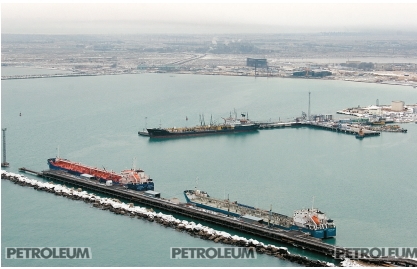Projects
Cheap Oil Devalues Offshore Projects
Arthur Shakhnazaryan, AtyrauKazakhstan’s offshore projects are only profitable if the oil price is $ 80-100 per barrel
Offers Below $80 Are Not Accepted!
Sauat Mynbayev,Chairman of the Board of the National Company KazMunayGas stated this spring that the oil production at the largest offshore Kashagan field is feasible only if the minimum corridor in the global prices varies from 80 to 100 dollars per barrel. Though the cracked pipeline prevent the operations, it means that given the current level of prices it would be unprofitable to produce oil.

The same concerns the other Caspian projects, which are currently in process of exploration: N, Zhambyl, Pearl (Zhemchuzhina). Mr. Mynbayev, speaking at the first international forum “Kazakhstan Geology Forum, Oil and Gas, 2015” said that N and Zhambyl project participants now take a decision on the future viability of these projects. Two years ago, in August 2013, the Head of the Ministry of Oil & Gas Uzakbai Karabalin declared the successful outcome of exploratory drilling at Zhambyl project.
Zhambyl site is located in the northern part of the Caspian Sea, in 20 km from the mouth of Kigach River (district сenter Ganyushkino), which is the border area between Kazakhstan and Russia. The volume of oil, produced during the pilot production was 60 tons per day, which is good for the onshore operations.
In the north-western part of Kazakhstan's Caspian sea, where the cost of production per one ton of oil is 2.5 -3 times higher and the risks are much higher, compared to the similar onshore projects, this volume clearly showed the lack of reserves for commercial development. All this is despite the fact that the Zhambyl field is an above-salt structure, i.e. it shall be more affordable and cheap for the development. The sea depth in the project area is from four to five metres. The total area of the block is 1935 square kilometres. Six above-salt structures were discovered at the block, with Zhambyl and Zhetysu as the main ones. There are structures that are considered as less commercial: Bibigul, Tuygyn, Gauhar and Eleanor.
First oil at Zhambyl was obtained when testing the exploration well. One can understand the joy of the oil industry leaders-there is a reason to rejoice, because it was the first producing well in the series of "dry" wells, during the Caspian offshore exploration, which was called by the experts as "Tyub-Karagan syndrome”. It was the first well in a new area in the north-western part of the Caspian Sea (North-Caspian elevation), and it showed the oil inflows. It is possible that this area of Kazakhstan’s part of Caspian offshore still has more prospects than the central part of the offshore (Buzazhinskaya), where Tyub-Karagan, Atash and Kurmangazy projects turned to be failure.
However, the prospects for Zhambyl project could not be regarded as certain ones. Moreover, the obtained debit was twice lower than expected, according to the preliminary forecast. The expected prospective geological oil reserves of Zhambyl amounted to 217 million tonnes, according to the estimations as of 2004. Expectations are justified by less than one third: in best case, there are about 100-105 million tons. We remind that the general geological reserves is not the same as"possible recoverable reserves". On the basis of obtained production rate, the recoverable reserves will hardly achieve $30 million tons.
The level of profitability for Zhambyl field is an opportunity to get at least 2 million tons of oil per year. It turns out that the level of even half a million tons annually is under question. The project unprofitable in the offshore conditions, with shallow waters and seasonal restrictions from 1-2 to 3-4 months due to environmental and climatic factors. And although according to the profile Ministry, the survey will be conducted at this area in future, actually it has been reduced dramatically and brought to the strict minimum. According to the national company specialists, the production rates do not comply with the expectations.
Seoul Have to Decide
It is noteworthy that the Procurement Plan for 2013 of Zhambyl Petroleum LLP- the operator of Zhambyl project also specified the exploration of Zhetyssu structure, in addition to Zhambyl. The total prospective geological oil resources in category P (50) of Zhambyl offshore site was 1.036 billion tons of oil. Geological oil reserves at Zhetyssu amount to 332 million tons. In the framework of the minimum exploration programme, it was planned to drill two exploration wells and to ensure 2D seismic survey.
But if Zhambyl didn’t justify itself, the shareholders didn’t dare to spend the funds for pure scientific study of Zhetyssu structures. There are no plans to drill Zhambyl or Zhetysu structure again in the current year of 2015. The total procurement volume of Zhambyl Petroleum company is reduced to 54 million dollars in the current year. And there's no expenses, stipulated for the exploratory drilling. Main expenditure items are only the seismic exploration in the area of abandoned well and the site environmental monitoring.
Formally, the final decision must be taken by the shareholders of Zhambyl Petroleum. But in reality, the decision depends on the South Korean side, because the full financing (100%) is ensured by the South Korean investor. And the Koreans will take the decision on several levels.
The backbone of Korean consortium is KNOC (Korea National Oil Corporation), which owns 35 percent of the Consortium. The remaining shares are distributed between SK Corporation (25%) and and LG International Corp. (20%). Samsung Corp. and Daesung Industrial Co. Ltd. owns another 10% each.



